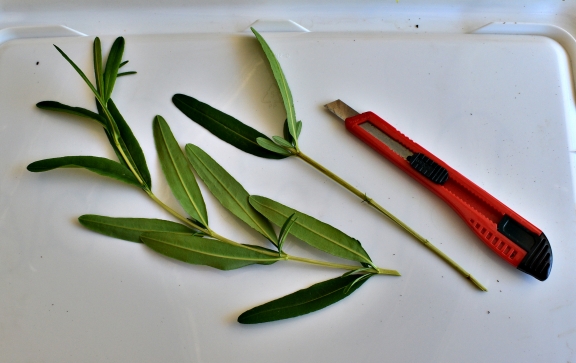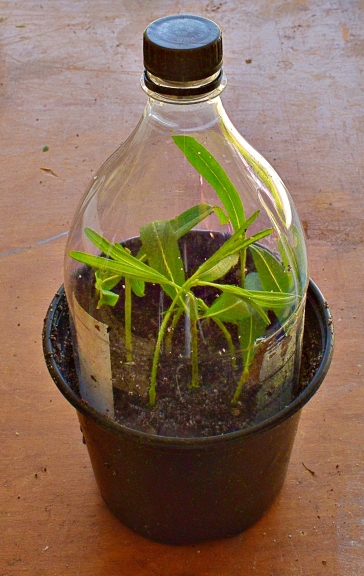Ode to Propagation
Taking cuttings with a snip
Is so easy, then you dip
Pretty soon you’ll have another
One for you and one for your mother!
It’s May! The best month for vegetative propagation! Yes, you can do it in other months, but there are more plant options now. I’ve included a list of plants and their recommended method of vegetative propagation in May. On the list is also indicated if the plant has rhizomes, if it does that is a good indicator that the plant propagates itself and forms clumps, but some do this slowly. If “best” is next to it, that indicates that separating the clumps is more successful than other methods. Let’s review the methods, easiest first.
Layering: This is great for a lot of shrubs. My mom used to bend a branch of anything she wanted to root down to the ground and put a brick or heavy rock on it. At the end of the season, in the fall, she would dig it up with roots intact, cut it off of the main plant and place it in the landscape where she wanted it to develop a stronger root system over the winter. That is still pretty much a great formula. You can also cover the part contacting the ground with some soil if you like.
Cuttings: can be divided into softwood and hardwood. May is the biggest vegetative propagation month because of the abundance of softwood available. This applies not only to shrubs but also to vines and herbaceous perennials. Softwood is the new growing stem. Hardwood, as its name suggests, has already become rigid. The method for taking the cuttings is the same.
1. Take cuttings with 4-6 leaves or leaf nodes. The cut should be done with a clean, sharp knife at an angle. You want as much surface area as possible, but you do not want to crush the stem, crushed cells rot. Take more cuttings than plants you want because some will not survive. If you wind up with too many plants, you can be a generous friend!
2. Remove all but the top two leaves. The tricky part about cuttings is the leaf surface that you allow to remain. It is a double-edged sword. On one side the leaf photosynthesizes to produce food so the cutting can grow roots, on the other side water is lost through evaporation from the leaf, and until the cutting has rooted the only surface area it has from which to take up water is that cut edge on the bottom. To hedge your bet, you can take many cuttings and vairy the amount of leaf surface you allow to remain. For large-leaved plants like hydrangea, cut the leaf to 1/3.
3. Dip the cut end of the stem in a rooting hormone and shake off the excess.
4. Then place it in your rooting medium. It is better if you dampen the medium first rather than watering later. Watering later can wash the rooting medium off. Push the stem all the way down in the medium until almost the leaves. This allows the stem to root at each node. Everyone has their favorite medium they like. Plain old garden soil can work, but I like a seed-starting mix to which I’ve added a good bit of sand. I like this because when I transplant them later there seems to be less damage to the roots when I take them from the pot.
5. Label and date it because you will not remember how long it has been since you started them!
6. Place a water-retaining cover, like a plastic soda bottle, over the cuttings and put the cuttings in the shade. (Full sun will cook them.)
7. Periodically check the soil for moisture, it should stay moist, but not soggy. It can take more than a month for your cuttings to root.
8. After a month, IF you have new growth of leaves you can transplant, but don’t be in a hurry; these are babies, give them time.
Division: The table mentions “root division”. This is different from plant division, and I have honestly never attempted root division. There has always been an alternative with which I am more familiar.
Plant Division: All the rhizomatous plants can be divided. For the herbaceous plants, this is usually a good time simply because you can see them! Dig up the whole plant and divide so that root, stem, and leaves go with each division doing the least amount of harm to the root system as possible. Use a sharp, clean knife. Replant immediately and water in. Expect a little dieback around the edges. For shrubs, I would wait until the fall so that the root system has the winter to reestablish in its new location.
Go Forth and Propagate!



